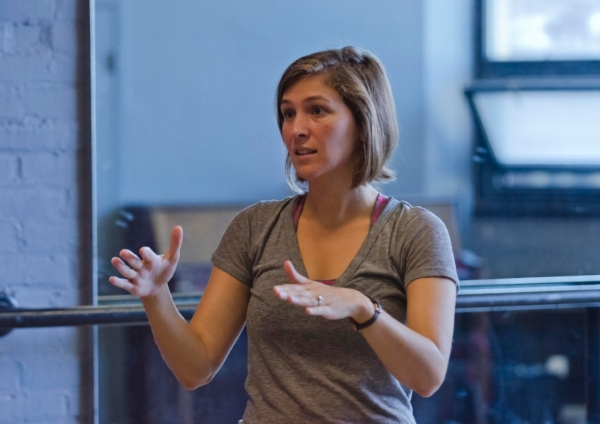BPT Talks About Design: a tiny q&a with BEASTS director Kelly Galvin

BPT Talks About Design (moderated by BPT Technical Director Jeffrey Petersen) will further expand the discussion with a focus on the contributions of designers and the role of design in new play development.
On Feb. 23, we’ll talk about Cayenne Douglass’s new play BEASTS:
BEASTS is a character-driven play that explores the chaos of American womanhood through the dark underbelly of a relationship between Fran, a pregnant suburbanite, and her older sister Judy, an irreverent artist with a propensity for disruption. When Judy hears that Fran’s husband Jim is on a business trip, she decides to pay Fran a visit. The friction between these siblings is palpable and only continues to intensify as Judy unearths confounding secrets and infringes upon the relationship that Fran has with her Doula Amelia, an elitist earth mama who’s been Fran’s only female friend since relocating back East. As their environment starts to mirror the anarchy of their psychological labyrinthine world, form and logic disintegrate into another realm as Fran and Judy unwittingly fight through pain to arrive at a crystallizing moment of realization. Read a Q&A with playwright Cayenne Douglass
We asked Kelly to share a little bit more about the role of the director in the development process:
Which director’s (or directors’) work do you follow? What’s inspiring to you about their career trajectory/ies?
Maria Aberg and Jamie Lloyd both have a way of approaching classical texts that gets to the thematic core in a completely theatrical way. I’m really inspired by that ability and how their productions of well-known texts feel totally fresh and original, but somehow also make me think, “Oh, obviously THAT is what this play is really about!” I was completely blown apart by the Cyrano that Jamie Lloyd directed for his company–a game changing piece of art for me.
Lavina Jadhwani is also one of my favorite directors of both classical and new plays. I’ve been lucky enough to assist her twice, and not only is she a brilliant, playful theatermaker with tons of heart, she also runs a truly collaborative, loving room in which artists are invited to be their full selves. She inspires excellence and rigor through creating a really joyful environment and it comes through in her work.
I’m also always following whatever Lileana Blain-Cruz is working on—her theatrical imagination and sense of rhythm blow my mind, and the way she talks about making theater and creating collaborative space never fails to inspire me.
As a director, you’re responsible for overseeing and guiding the vision for the play. How do you prefer to begin?
When I’m working on a new play, I want to be in an ongoing conversation with the playwright so that I know I’m working in alignment with their vision for the piece and that I’m supporting them as they work to articulate and capture that vision. Once we bring the design team into the process, I’m most interested in how we build a consensus around the playwright’s vision. There’s a kind of alchemical process where the play goes from being the playwrights’ vision to a collective vision—but that has to happen really thoughtfully and organically so that it grows authentically from the playwright’s vision and doesn’t hijack it. I love theater because it’s collaborative, and I trust that based on our collaborative conversations, we can grow that collective vision.
From there, the designers can create something that the playwright and I could never have imagined. I’m always striving to create that space in which we’re all on the same page about the story we’re telling, and how we want to tell it, and that each artist still has plenty of room to interpret that in their unique way. Having plenty of time to talk, brainstorm, share images and sounds that evoke the play for us, hear sections of the play out loud with actors—all of this gives us the time and space to create that kind of consensus.
What was the last play you saw before the coronavirus shutdown? How do you reflect on that experience today?
Wow, what a great question! I haven’t asked myself this, and I really had to search back. It does feel like eons ago. It was a production of Macbeth that I directed for the New England schools tour at Shakespeare & Company in Western MA. It was a six person, 90-minute version of the play, and I saw the troupe’s first public performance at a high school in Connecticut.
What stands out to me was that we used staves in the production, not only as weapons, but also as instruments to create different rhythms throughout the play, and during this specific performance the audience started picking up on the rhythms and joining in by stomping and clapping. It was so exciting and alive! Just that simple act of the audience picking up what was going on onstage and instinctively becoming part of it was really electric. Looking back, it reminds me that that’s ultimately what’s so special about live theater—that energetic interaction between the actors and the audience, however it manifests in each production. It’s what I most miss about making live theater and what I’m most excited to get back to.
—
We hope you’ll join us on Feb. 23 to talk about BEASTS! You’ll need the Zoom app (it’s free!) to participate, and it is recommended you call in a few minutes before “curtain” time. The Zoom link will be available here (scroll down); click here to learn more about the other plays featured in the BPT Talks About Design line-up.